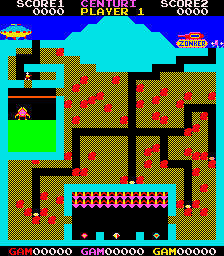The Pit (video game)
| The Pit | |
|---|---|
|
The Pit | |
| Developer(s) | AW Electronics |
| Publisher(s) |
Taito (JPN) Centuri (US) Zilec/Zenitone (UK) |
| Platform(s) | Arcade Commodore 64 |
| Release date(s) | 1982 |
| Genre(s) | Action/strategy |
| Mode(s) | Up to 2 players, alternating turns |
| Cabinet | Upright |
| CPU | Z80 (8-bit, 3.072 MHz) |
| Sound | Z80 (8-bit, 2.5 MHz); AY-8910 x 2 (1.536 MHz) |
| Display | Raster, 224 x 256 pixels (Vertical), 99 colors |
The Pit is a 1982 action/strategy video game developed by AW Electronics, published by Centuri in the United States, Taito in Japan, and Zilec/Zenitone in the UK. The objective of The Pit is to descend into an underground labyrinth, retrieve a gem, and escape.
A game similar to The Pit programmed by Chris Gray inspired Peter Liepa to create Boulder Dash.[1]
Description
The Pit is comparatively rare and difficult. The player's avatar (described as "The Astronaut-Explorer" by the game manual) lands in a spaceship and must dig his way into a series of underground tunnels. While there, he must avoid being crushed by rocks, eaten by monsters, impaled by arrows, or melted in a vat of acid. In lieu of a traditional timer is a tank (the "Zonker") shooting away a mountain near the player's spaceship. If the player dallies too long in the maze, the Zonker will destroy the player's spaceship, and the player loses a life.
After collecting the treasure, the only route back to the spaceship is by crossing "The Pit", which is a room with a sliding retractable floor underneath which is a monster that will devour a player who tarries too long.
Scoring
The player receives 200 points for shooting each enemy, 1000 points for each crystal collected, 2000 points for collecting buried treasure, and 1000 points for crossing "The Pit" safely and reboarding the ship.
Ports
The game was ported to the Commodore 64 in 1983. Bandai created a portable VFD handheld version of The Pit in 1983. It is called "FL Exploration of Space Zackman: The Pit". It was also sold by Tandy in the US and some European countries as "Zackman, Tandy Space Explorer".
Regional differences
The tank is labeled "Zilec" in the U.K. version, and "Taito" in the Japanese version. In addition, the game map layout as well as the color palette differ between the regional versions.
References
- ↑ Arno Eduard Weber, Interview with Peter Liepa, October/November 2005, published on boulder-dash.nl, cit. The publisher put me in touch with Chris Gray, who had submitted a game in Basic, but didn't at the time have the skills to convert it into machine language... The game was similar to an arcade game called The Pit, but after examining it more I didn't think the game had any 'legs' – too much of it was predetermined. But I started playing with basic elements of dirt, rocks, and jewels and within a couple of days had built the basic "physics engine" of what was to become Boulder Dash.
External links
- The Pit at the Killer List of Videogames
